Ventilation in a private house: supply and exhaust systems + tips for arranging
Due to poorly organized air exchange, the microclimate in the cottage often becomes unfavorable and uncomfortable. As a result, people living in it feel worse, and decoration and furniture suffer from excessive humidity or excessive dry air. And only well-organized ventilation in a private house can prevent these problems.
And how to properly equip it and what type of system to choose? We will consider these issues in our article. We will also figure out the choice of the optimal ventilation scheme for the cottage and ensuring a sufficient level of air exchange in individual rooms of the house.
The content of the article:
Classification and types of ventilation systems
The creation of ventilation in the cottage is due to the fact that it must be a continuous exchange of air masses. Old, used air with a large amount of carbon dioxide must be removed from the premises, replacing the constantly containing oxygen with a new one - from the street.
If you stop this air exchange, then the microclimate inside will quickly become far from favorable for human health.

In order to maintain the air exchange parameters established by GOSTs, the ventilation system in the house, made by yourself or with the assistance of third-party installers, must continuously change the air in the rooms.
For example, for living rooms in a cottage, the air exchange rate per hour is set to “1”. That is, in an hour, the entire volume of air must be completely replaced in them.
The purpose of ventilation is to combat the following factors:
- excess heat;
- constantly appearing dust;
- excessive humidity;
- harmful gases and vapors.
Every person in the house exhales carbon dioxide around the clock.Also in the residential building there are fireplaces, gas and electric stoves, numerous household appliances, that is, there are a lot of sources of heat, moisture, dust and gases in the cottage. And all this must be removed from the premises so that the microclimate in them is suitable for living.
By the method of moving air, ventilation systems are:
- With natural traction.
- With mechanical motivation.
First option involves the movement of air masses due to the existence of a pressure difference outside and inside the ventilated building. Moreover, it can be organized - using adjustable valves, and unorganized - exclusively through windows, doors and air in the foundation.
In the second case air is forced to move through rooms and ventilation ducts using mechanical devices. This option is volatile, but more efficient.

By appointment, ventilation systems are divided into:
- inflow;
- exhaust;
- combined.
The former work to supply air to the house from the outside, and the latter to extract from the building. The third option - the supply and exhaust structures are a symbiosis of the first two. Features of the calculation of the supply and exhaust system we examined in detail in this article.
Principles of operation of ventilation
Previously, housing was built with wooden windows and doors. Moreover, they did not shine with special tightness. As a result, through the existing cracks there was a constant and natural exchange of dirty indoor and clean street air.
However, now they have been replaced by plastic window and door blocks, which are much more airtight. Therefore, as an option, they put a special device on such windows - supply ventilation valve.

The principle of operation of the house ventilation system is based on a continuous influx of new air masses from the street. As a result, they gradually replace the air available in the rooms, squeezing the old out. In this case, carbon dioxide, odors and moisture are removed from the house.
The points of influx of new air are:
- window;
- doors
- vents in the foundation and base;
- window air conditioners.
We talked about the supply ventilation in detail in following material.
The removal of used air from the premises occurs through windows and doors during ventilation, as well as a ventilation pipe (shaft) or exhaust valve.
Option # 1 - Natural draft system
Non-mechanical type ventilation system works due to the formation of natural draft in a vertical pipe.
This is the principle of operation of a classic chimney of a wood stove or fireplace. In both cases, downward pressure builds up, pushing the air up and out.

Also, traction is affected by air saturation with moisture. The drier it is, the harder it is. Wet air masses inevitably tend to rise under the ceiling and further into the ventilation duct if it goes out of the building.
The main disadvantage of natural ventilation lies in its poor handling. In high winds, formation is possible reverse thrust. In winter, due to the temperature difference, the system works very efficiently, in some situations even in excess, drawing precious heat out of the house.
And in the summer its effectiveness drops dramatically.The temperature indicators in the rooms of the cottage and on the street in the summer period do not differ much, so the draft is inevitably reduced.

To control the quality of air exchange in such a system, the ventilation ducts in it must be equipped check valves. If necessary, it will be possible to cover them in order to reduce natural traction.
Option # 2 - Forced Drive System
If the natural ventilation system is not able to maintain the proper microclimate in the cottage, then it has to be changed to supply or exhaust mechanical ventilation.
In this case, the air flows are forced to move through the interior using fans.
Combined system variation is also possible - with supply and exhaust circuit. In it, the volumes of both the inflow and the exhaust are controlled by the ventilation units.

In some situations, such a system is additionally set recuperatortaking heat from the air from rooms and then giving it to the street.
Exhaust fans are installed in each room or one on the ventilation shaft. And the supply devices in private homes are usually equipped in the form of wall-mounted air vents with an axial electric fan inside.
But a variant is possible with a single supercharger of air and ventilation ducts in the building.
If forced-air and exhaust ventilation is done, then it requires laying two separate ventilation ducts - one goes to the hood, the second to the inflow.
This seriously affects the cost of the system, but allows you to more accurately regulate and control it.
What is the best scheme for a cottage?
To determine what and how best to equip ventilation in a private house, you need to consider a lot of factors. The characteristics of all engineering systems and building heating devices are important here.
When choosing the right type of ventilation system, consider:
- climatic features of the area;
- the presence near the house of sources of unpleasant and harmful impurities in the air;
- assignment of different rooms;
- individual features of the architecture of the building;
- the presence of gas stoves or boilers, as well as fireplaces or stoves for wood / coal;
- the number of permanent residents in the cottage and much more.
It is recommended to design and install independently only natural ventilation. For its calculation, simplified methods with averaged indicators are used. Understanding them is not difficult.
For living rooms, the air exchange speed is set at 30 m3/ hour, for bathrooms and toilets within 25-30 m3/ hour, and for the kitchen - 70-100 m3/hour. Based on these data and the cubic capacity of the rooms, you only need to calculate the width of the ventilation ducts, and then equip them in the building.
And to do this is best at the design stage of the cottage. Often the best option is a ventshaft in the middle of the structure with its output above the ridge of the roof.
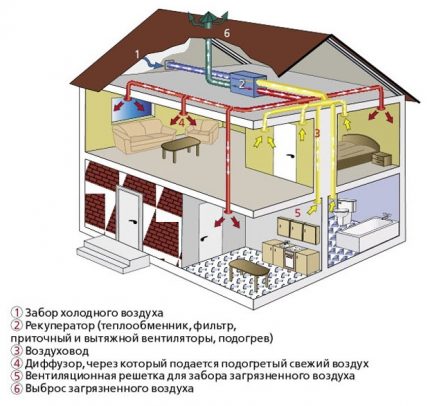
If a private house is being built in two or three floors and a forced air exchange system is chosen for it, then it is better to entrust its design to a professional. Installation can then be done with your own hands.
However, if there is no experience in such a matter and do not want to encounter problems in the future, then the installation of all ventilation equipment should also be delegated to a specialist.
Compared to mechanical, natural ventilation is cheaper, less noise and does not depend on the availability of power supply. However, it is more difficult to regulate. Plus, the thrust in it is highly dependent on external atmospheric factors.
But the lack of electric fans is the absence of problems with breakdowns and the need for their maintenance.
Forced ventilation system in a private house in a combined or only exhaust or supply air version is more difficult to install and operate. However, it allows saving on heating and more precisely controlling the microclimate in the cottage.
Recommendations for individual rooms
Air flows during the arrangement of any ventilation in a private house are built in such a way that clean street air enters first into the living room, bedrooms, study and library.
And then, along the corridors, he should go to the kitchen, the bathroom and the pantry with access to the exhaust ventilation shaft.
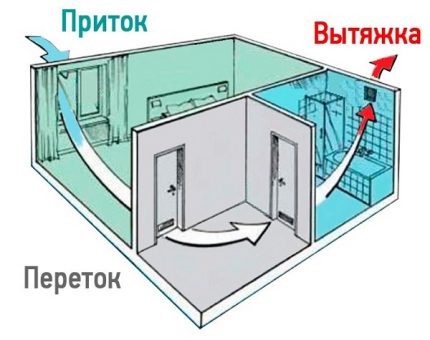
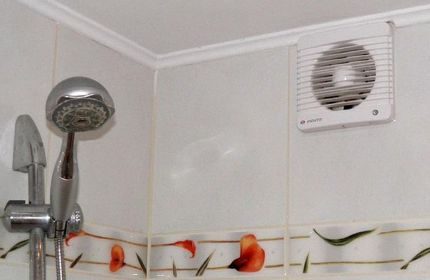
In the kitchen, in addition to the ventilation hole, it is recommended to additionally put in the ventilation duct cooker hood. It will allow you to quickly remove the smells of cooking, preventing them from spreading to other rooms in the house.
A separate moment is a boiler room and a kitchen with gas equipment. They must be equipped with a separate channel for air flow directly from the street. Plus do not forget about the chimney.
So will the oxygen for combustion enter the furnace in the required volume, and carbon monoxide will immediately leave the room.
Conclusions and useful video on the topic
From the following video you can learn how to properly draw up a ventilation project:
How to implement fresh air ventilation in the cottage with your own hands:
The principle of operation of the intra-house ventilation system:
The easiest and cheapest way to make a classic natural ventilation in a private house.
But if the cottage is large in size, with many residential and non-residential rooms, a fireplace and gas equipment, then it will be necessary to equip its mechanical counterpart. This system will cost more in installation and operation, but the air exchange and microclimate inside will be at the proper level..
Compare ventilation systems for a private house and can not decide on the best option in your case? Ask your question to our experts in the comments to this article.
Or maybe you still have questions about the nuances of arranging the ventilation system and the rules for choosing equipment? Ask for advice in the comments section - we and experienced visitors to our site will try to help you.

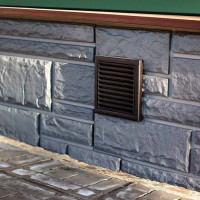 Natural ventilation in a private house: rules for arranging a gravitational air exchange system
Natural ventilation in a private house: rules for arranging a gravitational air exchange system 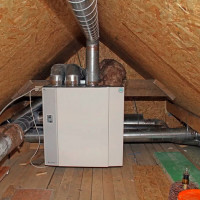 Ventilation in a two-story private house: options for organizing trouble-free air exchange
Ventilation in a two-story private house: options for organizing trouble-free air exchange 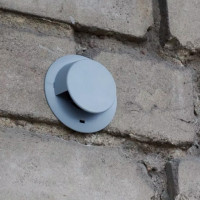 Ventilation in a private house from aerated concrete: options and methods of construction
Ventilation in a private house from aerated concrete: options and methods of construction 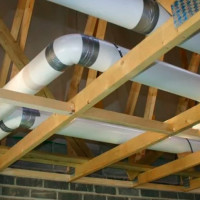 Ventilation from plastic sewer pipes in a private house: the possibility of construction and the best options
Ventilation from plastic sewer pipes in a private house: the possibility of construction and the best options 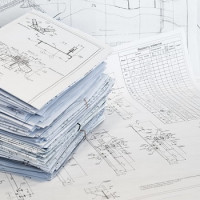 Typical schemes and rules for designing a ventilation system in a private house
Typical schemes and rules for designing a ventilation system in a private house 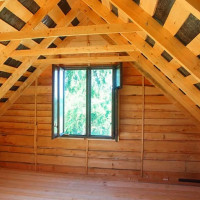 Attic ventilation in a private house: how to make ventilation through gables and dormers
Attic ventilation in a private house: how to make ventilation through gables and dormers  How much does it cost to connect gas to a private house: the price of organizing gas supply
How much does it cost to connect gas to a private house: the price of organizing gas supply  The best washing machines with dryer: model rating and customer tips
The best washing machines with dryer: model rating and customer tips  What is the color temperature of light and the nuances of choosing the temperature of the lamps to suit your needs
What is the color temperature of light and the nuances of choosing the temperature of the lamps to suit your needs  Replacement of a geyser in an apartment: replacement paperwork + basic norms and requirements
Replacement of a geyser in an apartment: replacement paperwork + basic norms and requirements
I planned to build a small cottage in the village by summer in order to relax with my family in the fresh air more often. And somehow I did not think about ventilation.But the cottage will be small, maybe just enough ventilation? Or will ventilators have to be installed in any case: with or without ventilation? And it’s also interesting whether ventilators need to be controlled or is there a program for optimal air flow into the room already arranged in them?
Good day, Andrey. You probably mean micro-ventilation on the windows. They work on the principle of opening the sash by 6 mm. This is to preserve heat in the cold season, while in warm time the window simply opens to “tilt”.
No, micro-ventilation alone is not enough. It is necessary to equip full ventilation in at least two rooms: in the kitchen and bathroom.
Understand ventilation works according to the principle of inflow / outflow of air. An open window is an inflow, but an outflow? It can only be in the case of opening windows on opposite sides of the cottage. Objectively, this is not a way out.